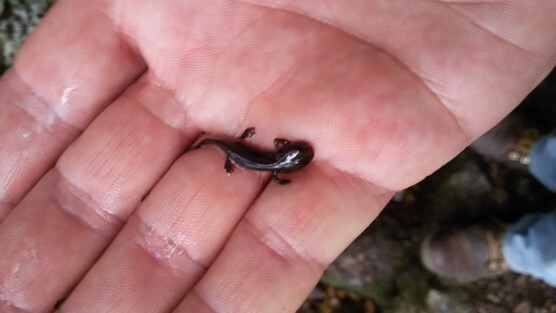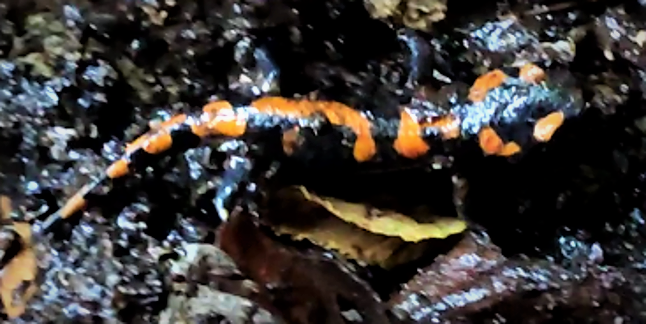La salamandra pezzata (Salamandra salamandra), appartiene alla famiglia Salamandridae. La salamandra pezzata è una specie che si trova nella terraferma e nelle penisole. Manca completamente nelle isole. In Campania la specie è presente solo in alcune aree montuose caratterizzate da un ricco reticolo idrografico superficiale come i Monti dei Picentini, i Monti del Partenio, i Monti Lattari ei Monti Alburni.
La specie sembra essere estremamente rara. È stata osservata quasi esclusivamente all’interno della Riserva Naturale Valle delle Ferriere, e recentemente anche in una località del settore orientale dei Monti Lattari (territorio di Tramonti). Altre aree potenzialmente idonee alla presenza della specie sono nel territorio di Gragnano e Corbara.
La salamandra pezzata è facilmente riconoscibile per il suo colore nero con macchie gialle. Raggiunge circa 15-20 cm di lunghezza totale (compresa la coda), e le femmine sono generalmente più lunghe e più grandi dei maschi. La pelle è liscia e lucida, è cosparsa di piccole ghiandole che secernono muco che ricopre l’animale; il muco ha una funzione battericida (protegge la pelle dalle infezioni), riduce la disidratazione e ha un sapore repellente per i predatori. I colori accesi della pelle indicano proprio che la salamandra non è commestibile: questi colori sgargianti sono chiamati “colori di avvertimento”. Le femmine depongono le larve in torrenti, fiumi o altri corsi d’acqua ben ossigenati. Le larve hanno branchie e quattro arti ben sviluppati. Le larve si differenziano dalle altre larve urodeli per la presenza di macchie luminose alla base degli arti. In alcune popolazioni montane di salamandra pezzata, le femmine sono vivipare e danno alla luce piccole salamandre completamente sviluppate che sono pronte per la vita sulla Terra.
La specie vive in boschi decidui e sempreverdi, quasi sempre in prossimità di piccoli corsi d’acqua caratterizzati da acqua limpida e ben ossigenata. Nidifica in piccoli ruscelli e laghi primaverili dove non ci sono pesci. In questi ambienti le femmine partoriscono in primavera le larve (da 5 a 10). La vita larvale dura circa due mesi e la metamorfosi avviene durante l’estate.
I principali fattori di minaccia alla sopravvivenza di questo anfibio sono rappresentati da modificazioni strutturali delle aree dove si sviluppano le larve: inquinamento delle acque di fiumi, torrenti e sorgenti, deforestazione e incendi, introduzione di pesci carnivori (es. trota, pesce gatto, carpe) nelle acque dei torrenti e delle pozze dove si trovano le larve.
The fire salamander (Salamandra salamandra), is belonging to the family Salamandridae. The spotted salamander is a species found in the mainland and at peninsulas. It is completely lacking in the islands. In Campania the species is present only in some mountainous areas characterized by a rich hydrographic network surface as the Monti of Picentini (mountains of Picenti), Monti del Partenio, Monti Lattari and Monti Alburni.
The species appears to be extremely rare. It was observed almost exclusively within the Nature Reserve Valle delle Ferriere, and recently also in a location of the eastern sector of Monti Lattari (territory of Tramonti). Other areas potentially suitable for the presence of the species are in the territory of Gragnano and Corbara.
The spotted salamander is easily recognizable by its black color with yellow spots. It reaches about 15-20 cm in total length (including the tail), and females are generally longer and larger than the males. The skin is smooth and shiny, is sprinkled with small glands secreting mucus that covers the animal; mucus has a bactericidal function (protects the skin from infection), reduces dehydration and has a taste that is repellent to predators. The bright colors of the skin indicate precisely that the salamander is not edible: these flashy colors are called “warning colors”. The females lay larvae in streams, rivers or other waterways well oxygenated. The larvae have gills and four well-developed limbs. The larvae differ from other larvae urodeli for the presence of bright spots at the base of the limbs. In some mountain populations of spotted salamander, the females are viviparous and give birth to small fully developed salamanders that are ready for life on Earth.
The species lives in deciduous and evergreen forests, almost always near small streams characterized by clear water and well oxygenation. It breeds in small streams and spring lakes where there are no fish. In these environments, the females give birth to larvae (5 to 10) in the spring. The larval life lasts about two months, and the metamorphosis takes place during the summer.
The main factors of threat to the survival of this amphibian are represented from structural modifications of the areas where the larvae develops this could be waters pollution of the rivers, streams and springs, deforestation and fire, introduction of carnivorous fish (eg trout, catfish, carp) in the waters of the streams and pools where it occurs larvae.

